Whether science and evidence agrees with it or not, these are 13 famous cheeses that are banned in the USA. Read on to learn about the cheeses, and why they were banned. Prefer video? Click on the link below to watch our YouTube video.
SEE ALSO: Why raw milk cheese is so important →
Reasons for the ban
The Food and Drug Administration has a lengthy and detailed set of regulations on cheese. Effectively, they have deemed a large number of traditional European cheeses to be unsafe for consumption in the States. Actually, the most common reason is the use of raw milk.
However, a few of them have been banned for other reasons which will be quite apparent when you read about the cheese. Without further ado, let’s delve into our list.
1. Brie de Meaux
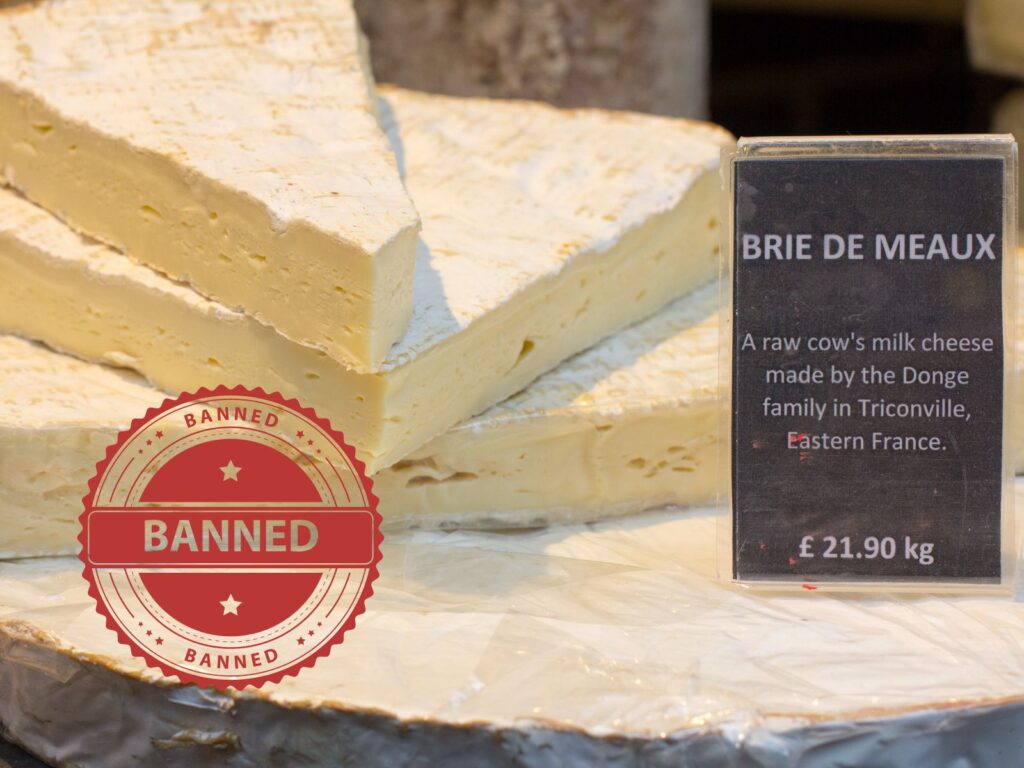
Brie de Meaux is a traditional soft cheese from the Ile-de-France region of France. For more than 400 years, artisans have been making this cheese in the region using traditional methods. To this day, they use raw cow’s milk and mature the wheels for four weeks. As a result of this, the FDA has banned this cheese in the United States.
2. Raw Milk Epoisses de Bourgogne
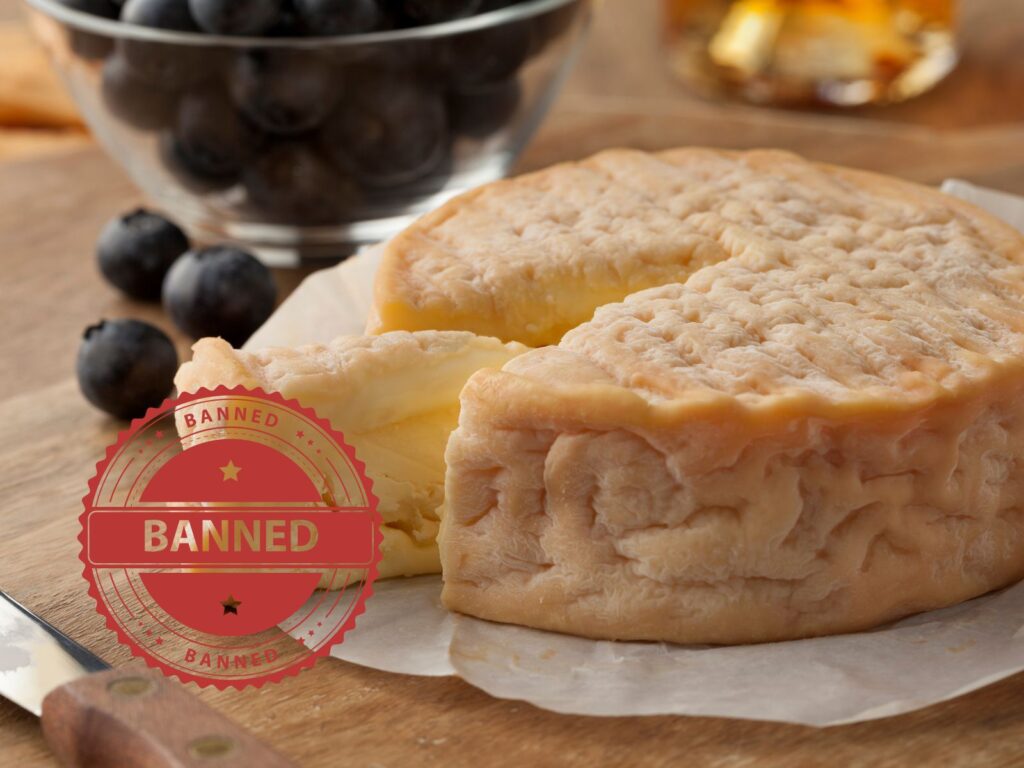
Epoisses de Bourgogne is a famous washed rind soft cheese from Bourgogne, France. At the start of the 16th century, local Cistercian monks developed this recipe and would eventually pass it on to the local farmers.
Nowadays, the locals still make Epoisses with raw milk cheese for the European market. Whilst this traditional version is not allowed for sale in America, you can have access to a pasteurised milk version.
3. Casu Marzu (Maggot Cheese)
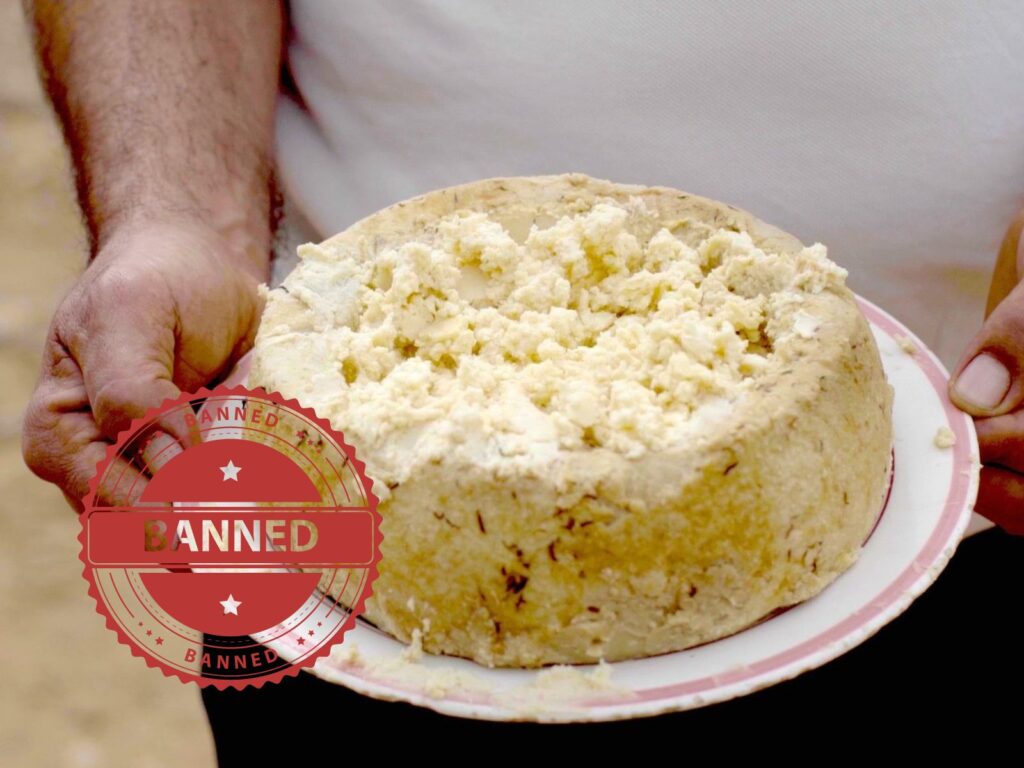
Casu Marzu is a maggot-infested cheese that originates from the Italian island of Sardinia. Effectively, the Guinness Book of World Records recognised this traditional product at the most deadly cheese in the world in 2009. Cheese skipper flies, Piophila casei, lay their eggs in cracks that form in wheels of Fiore Sardo.
Afterwards, their maggots hatch and make their way through the insides of the cheese. Over time, they digest the milk proteins and transform the insides of this Pecorino into a soft creamy cheese. Do I need to tell you why this cheese is banned?
4. Reblochon de Savoie
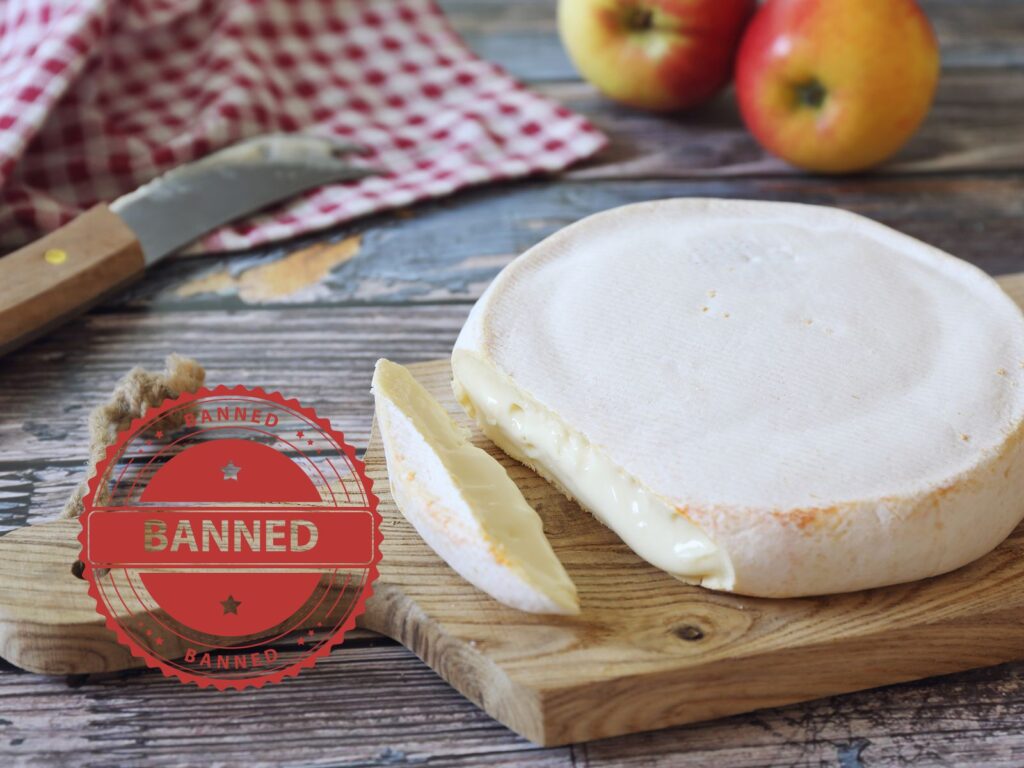
For centuries, small batch cheesemakers in the Savoie region of France have been making this soft washed rind cheese using rich cow’s milk. Since they make Reblochon with raw milk, it does not meet the FDA’s regulations for food safety in the USA.
However, you can get your hands on a decent pasteurised milk version called Le Délice du Jura. And if you’re in Australia, there is a wonderful Reblochon-style cheese called Mountain Man.
Want to learn more about this cheese? We’ve got a complete guide to Reblochon’s history, production and organoleptic properties here.
5. Camembert de Normandie
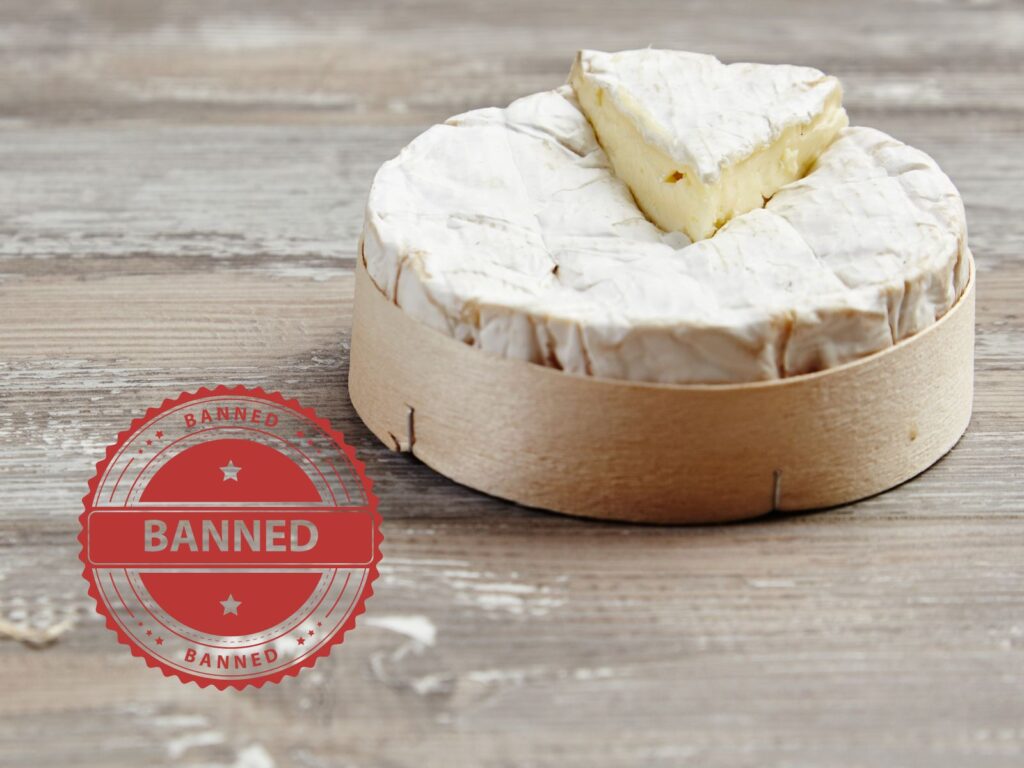
Camembert is a soft bloomy cheese that originates from Normandie, France. Since the late 18th century, farmers in the region have been using the unpasteurised milk of their Normande cows to make small wheels of Camembert.
After forming the wheels, they mature each cheese for three to four weeks. As a result of the short maturation period, Camembert de Normandie is unavailable in the USA!
6. Sainte-Maure-de-Touraine
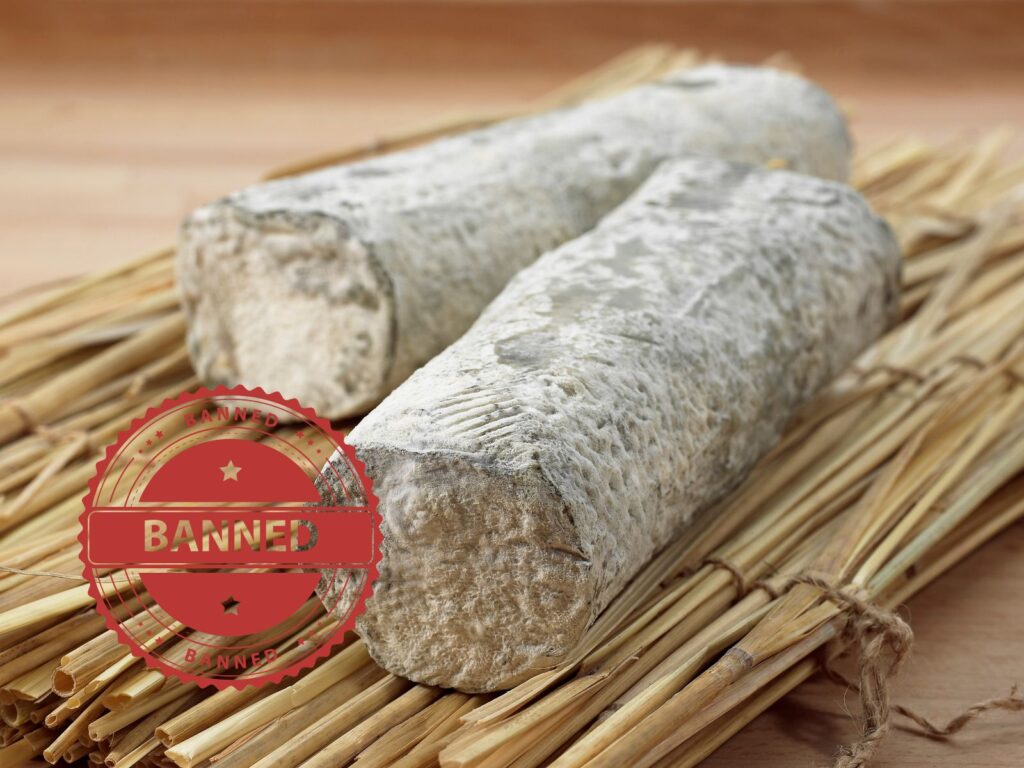
The village of Sainte-Maure-de-Touraine lies north of Poitiers, in a region that is renowned for log-shaped goat’s milk cheeses. One such cheese is the eponymous Sainte-Maure-de-Touraine. As shown above, a distinguishing characteristic of this particular cheese is the thin straw stick that runs through its centre.
Whilst the traditional raw milk version is prohibited in the USA, you will find some pasteurised milk versions. One such example is Bûche de Montrésor.
7. Mimolette Extra-Vieille
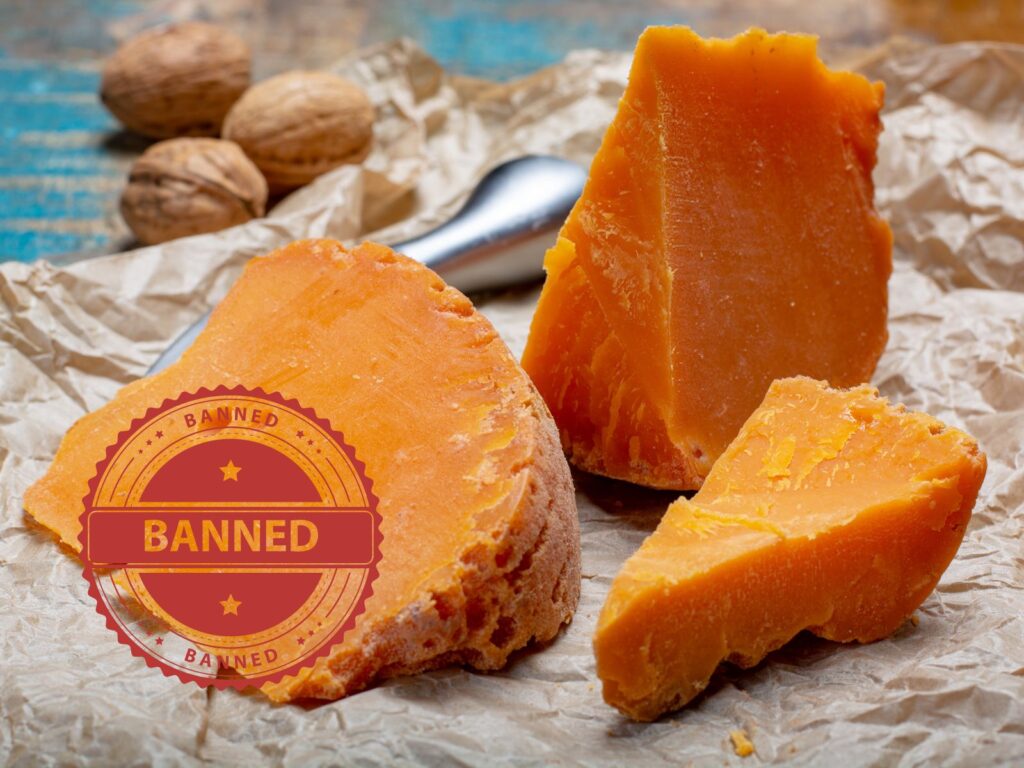
Mimolette Extra Vieille is a brightly coloured pressed cheese that comes from Lille, Northern France. At 12 months, Mimolette has a distinctive greyish rind, which resembles the skin of a cantaloupe. Actually, it is the work of the world’s smallest affineurs, the cheese mites (Acarus siro).
Significantly, the mites create tiny holes on the rind and edge of the pâte. Moreover, they make a strong contribution to the unique flavour of this cheese. Over the years, those mites have fallen in and out of favour with the FDA. So, the availability of this gorgeous cheese has been sporadic at best.
As of 2022, you can find all versions of Mimolette at cheese counters in the USA except for Mimolette Vieille. You can read more about the FDA ban on Mimolette in our comprehensive post here.
8. Bleu de Gex
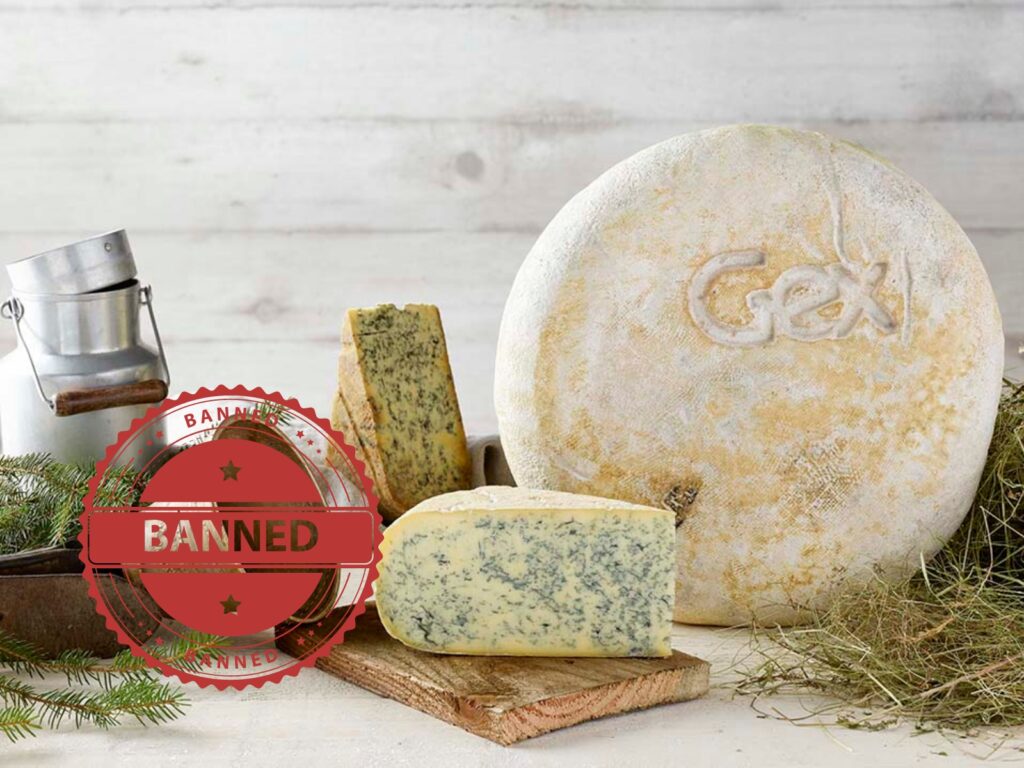
Finally, Bleu de Gex is a blue cheese that originates from the Jura region of France. Actually, the locals know the cheese as Bleu du Haut Jura. Today, the cheese is still produced in small mountain dairies. Indeed, local artisans continue to use a 14th century recipe and traditional methods.
The AOC dictates that cheesemakers can only use unpasteurised milk to make Bleu de Gex. And you guessed it! That’s why it is not available in the USA.
9. Banon
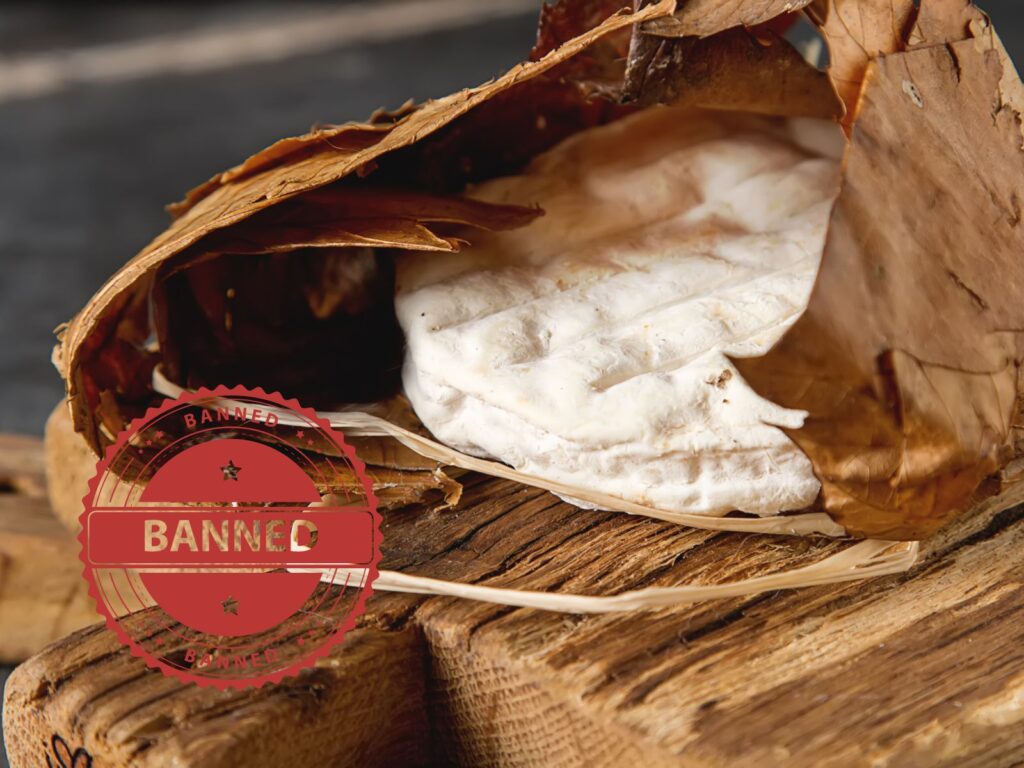
Cute little Banon is a soft, raw goat’s milk cheese that finds it roots in Alpes-de-Haute-Provence. In fact, it draws its name from a small eponymous village in between the Lure mountain and the famous Mont Ventoux.
The AOP dictates that Banon cheesemakers have to use exclusively raw, whole goat’s milk to make this protected cheese. Moreover, they age each little wheel for a minimum of 15 days. As you’ve probably guessed, the use of raw milk and short maturation period are why Banon is banned in the USA.
10. Morbier
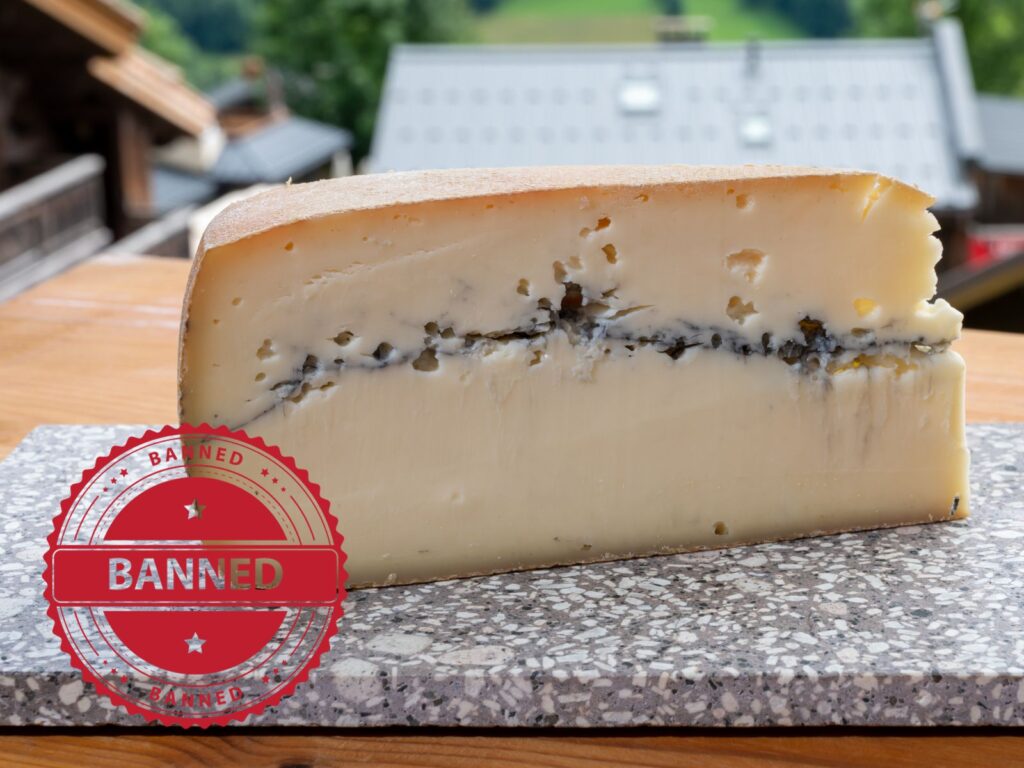
Morbier is a semi-soft, cow’s milk cheese that originates from the Franche-Comté region of France. It is known for its distinct appearance, with a layer of ash running through the centre. The ash used in Morbier cheese is typically vegetable ash, and it is primarily a traditional and aesthetic feature.
In a stunning move by the FDA, Morbier finds itself on the ban list as of November 2023. The reason for this is the line of ash which the FDA has suddenly decided is not food-safe.
11. Azeitão
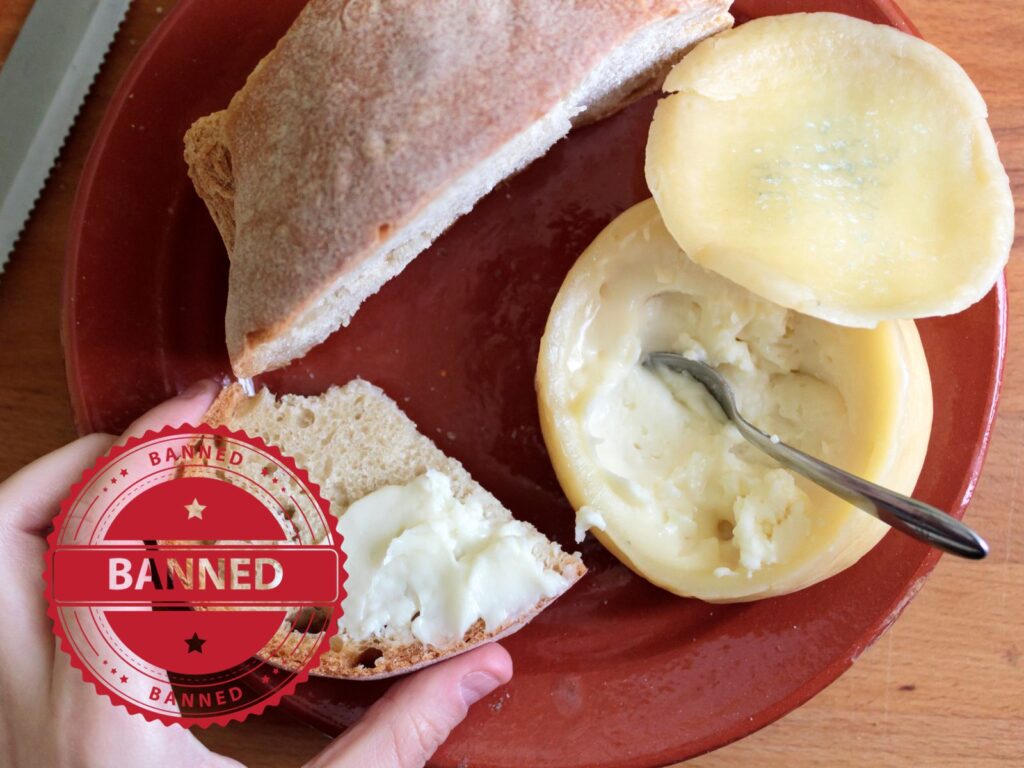
Azeitão cheese, also known as Queijo de Azeitão, is a traditional Portuguese cheese made from raw sheep’s milk. It is a soft, creamy cheese that is usually aged for a short period, typically around 20 to 30 days.
Because of the use of raw milk and its short maturation cycle, Azeitão does not meet the FDA’s guidelines and finds itself on the ban list!
12. Queijo da Canastra
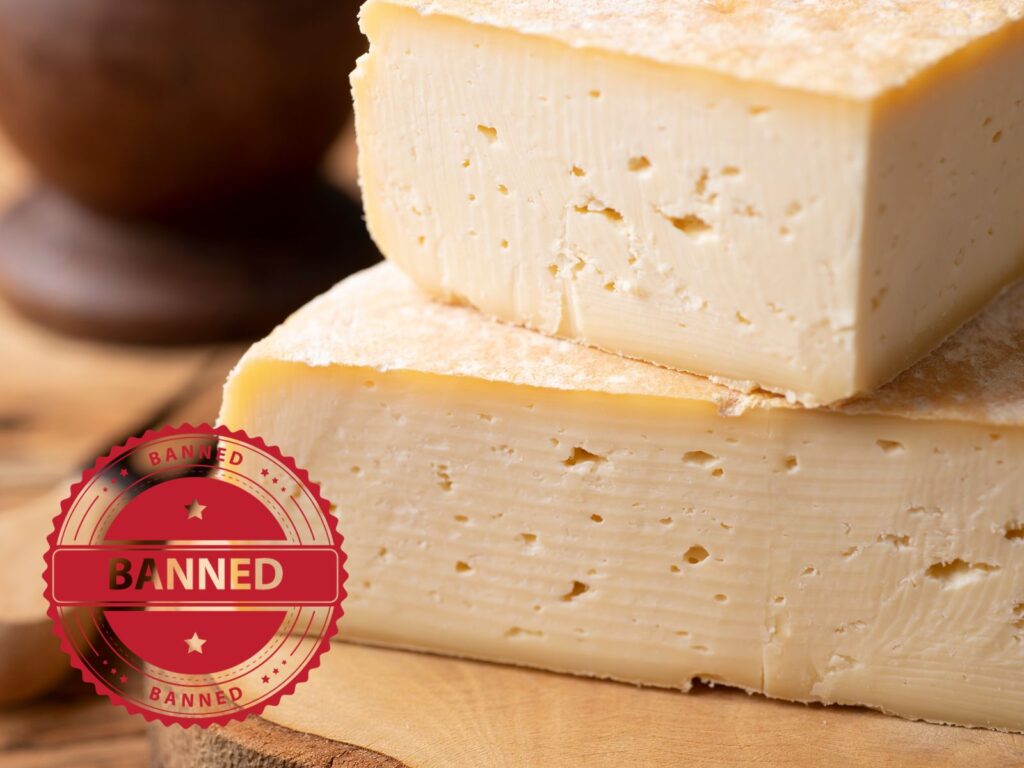
Queijo Canastra, also known as Canastra cheese, is a traditional Brazilian cheese made from raw cow’s milk. It originates from the Serra da Canastra region in Minas Gerais, Brazil. Canastra cheese is a semi-hard, artisanal cheese with a yellowish colour and a strong, tangy flavour.
When made according to the traditional recipe, this cheese is aged for 21 days. Hence, it is another raw milk cheese that falls victim to the FDA’s dubious rules.
13. Brocciu
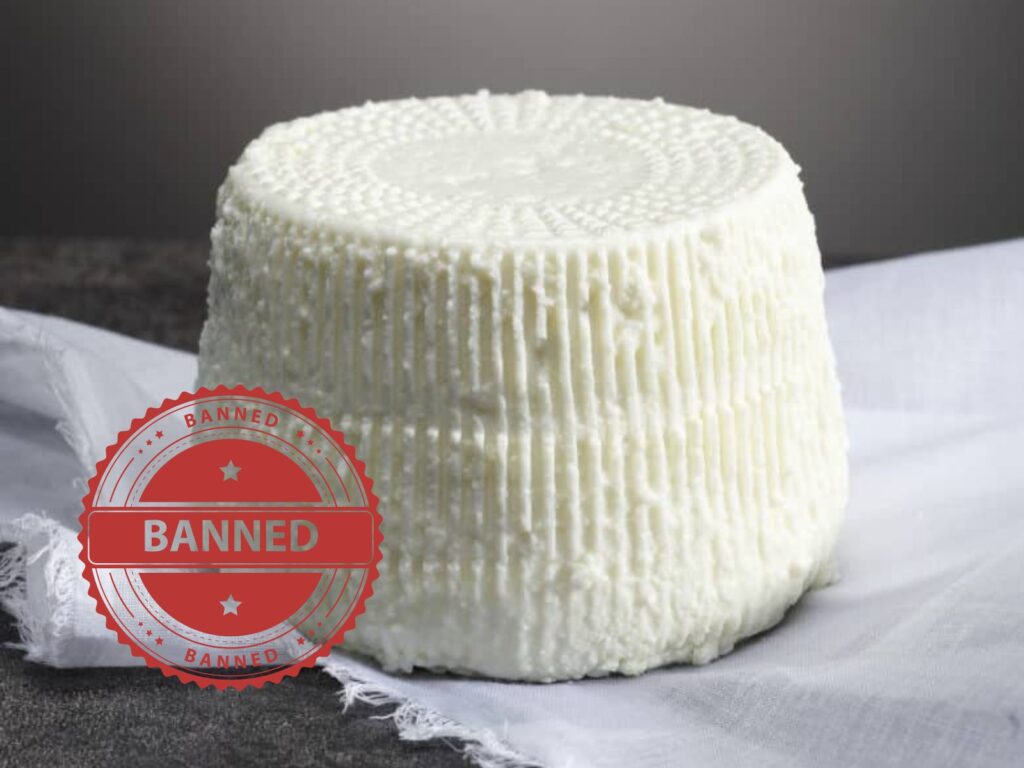
The final cheese on our list is a fresh, creamy ewe’s milk cheese that finds its roots in the Île de Beauté (Beautiful Island), Corsica. Made using a mixture of sheep’s whey and milk, Brocciu has a gorgeous white paste with a mousse-like texture.
The traditional recipe for this hybrid whey cheese requires unpasteurised whey and whole milk. This fact, coupled with a maturation phase of 21 days, means that the FDA has banned the importation and sale of Brocciu in the US.
Should these famous cheeses be banned in the USA?
I hope that you enjoyed reading this article. The discussion around whether those famous cheeses should actually be banned in the USA is a very polarising one. How is it possible that so many cheeses are deemed safe in Europe, but not in America?
I’d love to hear your thoughts on the matter. Drop us a line below.
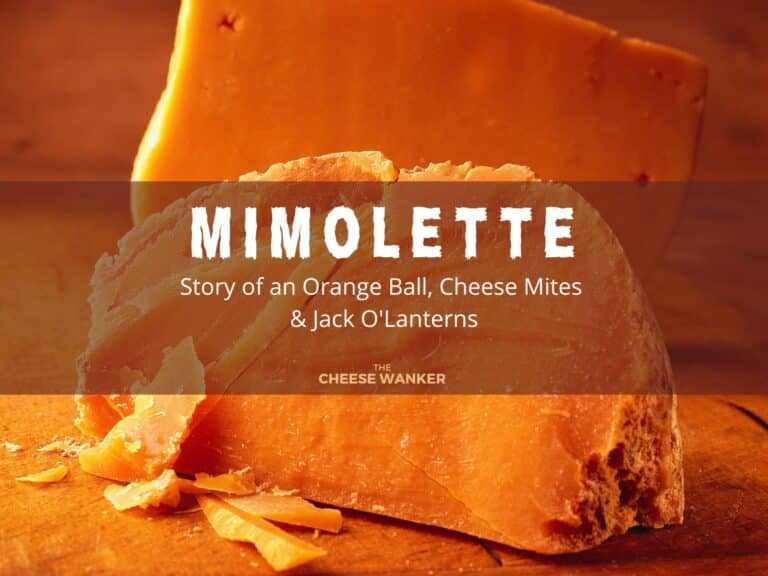
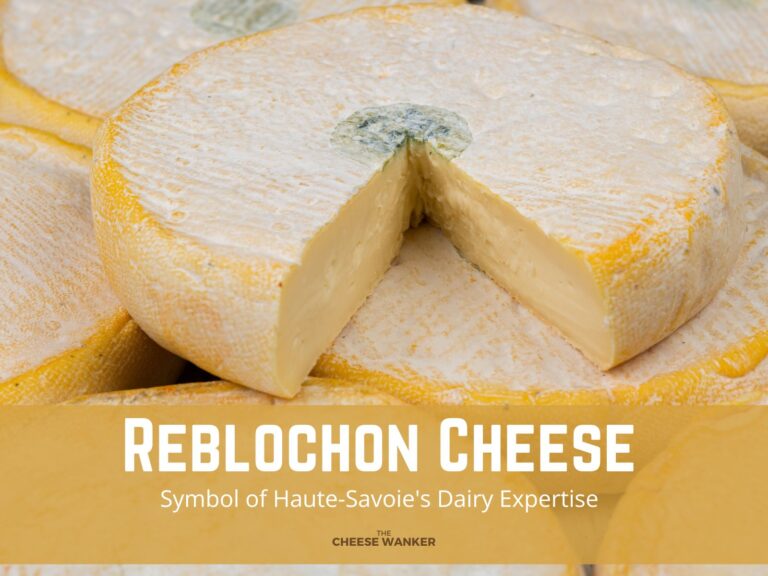
Fascinating! I don’t know if any of these cheeses are banned in the UK…Who knows after the dreaded Brexit. When I have a spare moment, I’ll check it out.
The UK is great when it comes to raw milk cheese. You’ve pretty much got the same regulations as the rest of Europe still.
There aren’t any cheeses that are banned in the UK, apart from Casu Marzu, which is banned everywhere. Even in Sardinia, where it’s made, it’s frowned upon by the authorities!
Is this cheese really banned in the U.S.?
Certainly is!
I have bought and sold most of these cheeses in a USA over the last 30 years but indeed they are harder to get hold of as . I think the restrictions are not always followed by certain customs agencies and it has varied over the last few decades . The article doesn’t mention the essential fact that the soft cheeses are over their peak by 28 days which is the limit for quarantining at site of production, raw milk cheese before they can be imported..
Its ironic that the USA has the worst food in the entire world. Casangenics are allowed, poison is allowed, insecticides thousands of times greater than the World Health Organisation’s highest recommended levels, hormone injected meat, gm crops and so on and so on. And yet they ban cheeses which are proven to be safe.
But on the plus side no argument from me it keeps the price down and that’s a plus for those in Europe who know what real food should taste like.
Anyone for a hormone injected beef pattie in a chemically processed bun? Sorry not available in Europe you have to go to the land of the fools that is the USA.
Oh and you have no idea what your missing if you cant buy washed rind cheese.
So you are telling me that USA, a country that produces and massively uses GMO crops, does not allow specific types of cheeses for fear of raw milk when the same time all the European Food Administrations have approved them.
Ok. Noted.
Indeed, while raw milk is legal in most US states, in others you can only obtain raw milk from your own cow. There are some places that let you buy a “share” in a cow, which is basically a membership to allow you to buy raw milk from the vendor.